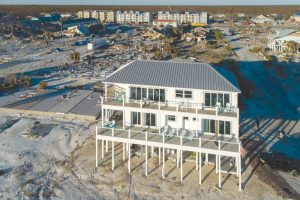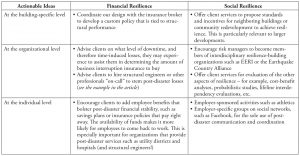Resilience may be the phrase of the decade, but it is not a new concept. Structural engineers have been building resilience all along; it is only now that others are catching on. And, as structural engineers, there are tangible steps we can take to amplify the resilience we build.
Consider the broader meaning of resilience: the ability of a person or system to adapt to shock and return to a “new normal.”
In this context, structural engineers need to ask: is structural design truly resilient, i.e., does it achieve its performance objectives, if related elements of resilience are lacking? Most engineers think only about the building. However, a building is only one part of the physical infrastructure, and the physical infrastructure is only one part of a city and community.
Some frameworks for thinking about resilience have a dizzying array of “spokes.” As a simpler alternative, consider the metaphor of stability: resilience as a three-legged stool. Resilient structural design can only serve its intended purpose if the other legs of the stool are also present. Are they?
The three legs are physical resilience (including safe buildings, lifelines, data), social resilience (including neighborhood cohesion, effective governance, NGOs, and many others), and financial resilience (including public aid, insurance, banks).
After the shock of a natural disaster, what good are safe buildings if no one stays to live in them?
The classic case in point: Hurricane Katrina in 2005. Fully 40% of the residents of New Orleans left and never returned. The population ticked back up but was mostly comprised of newcomers. And now, a mere 14 years later, New Orleans suffered another debilitating flood.
The last thing structural engineers should want is for their building to be “resilient in a vacuum,” i.e., functional but abandoned, whether for lack of occupants, finances, infrastructure, or political will (Figure 1). When structural engineers understand and incorporate these other, interrelated parts of resilience, they increase the chances that their designs will achieve true resilience. It will help prevent their good work designing reliability, predictability, redundancy, and reparability from going to waste.
However, how do structural engineers incorporate inter-disciplinary notions of resilience into their design? It will vary across context, project, physical setting, and ownership, but the intent of this article is to provide food for thought.
Redundancy: Notably Lacking
We have all seen the social and economic disruption from extreme disasters, and it is frightening to imagine that your home town could be next. What has become abundantly clear is the lack of redundancy in our social and economic systems.
Vulnerabilities exist across all dimensions of resilience, including infrastructure/lifelines, post-event governance, and social connectedness. Making this last point by counter-example, the research of Daniel Aldrich at Northeastern University convincingly shows that communities with high degrees of social connectedness have demonstrably better disaster outcomes – not only survival and displacement rates but also the speed of recovery in the medium- to long-term. And “social connectedness” extends to electronic connectedness. Social media as resilience-builder? Heck, yes!
However, perhaps most fragile is our financial structure. Even a cursory glance at post-disaster financial systems reveals a staggering lack of savings at both macro and micro scales.
At the federal level, FEMA continues to provide post-disaster Individual Assistance grants, but the public is becoming more and more pessimistic about the timeliness and availability of federal relief. Likewise, FEMA messaging itself has shifted to downward-manage public expectations on grant amounts.
At the municipal and state levels, public entities must constantly balance competing priorities. It might win votes in the short-term to use limited resources to solve here-and-now problems, but this puts a strain on the number of resources available for emergency reserves.
Worst of all is the systematic lack of savings at the individual level. Annual surveys by Bankrate repeatedly show that a staggering majority of Americans lack even $1,000 in savings. What this means is that the unanticipated expenses of a natural disaster – even just the cost of evacuation – could tip a family into a spiral of debt.
The leverage of financial resilience cannot be understated. Case studies from two different historical and cultural contexts make this point.
Recovery is Driven by Money: Case Studies
Figure 2 is a photo of the 1906 San Francisco earthquake showing a group of people on Potrero Hill, smoke billowing in the background. Their city is in flames, yet they are smiling, as if undaunted. They possibly foresaw what would happen over the next decade: massive public and private investment, $50 million at the time. In today’s dollars, considering the population in 1906, this amounts to $2,500 per capita – which is astounding because it is 5 to 10 times the per-capita post-disaster disbursements that are typical in recent decades. This allowed San Francisco to bounce back so definitively that it hosted the 1915 Pan-Pacific Expo and established itself as an international destination.
Something similar happened in the decade after the M7.7 2001 Bhuj (India) earthquake. It was a tragic disaster for thousands of people, but at the macro level, it was a financial success story. The state and national government quickly invested $2 billion into the rebuild. This had the flywheel effect of attracting another $10 billion or more from the private market, enough to create momentum for a remarkable economic boom. Over the following decade, the state of Gujarat experienced 10% GDP growth, and the employment of women doubled. Some have gone so far as to call this the “Gujarat miracle.”
Extending Our Reach: Contingency-Planning
Disasters cause unanticipated consequences unrelated to damage, which have real costs and affect recovery, and structural engineers have the know-how to extend resilience-building beyond just construction documents. Here are two examples from the M6.0 Napa earthquake in 2014.
This first example demonstrates how the client can gain critical information for contingency-planning if the structural engineer performs an assessment of the immediate vicinity.
Velo Pizza is a thriving local business in Napa in a historic masonry building. The owners had done the right thing and had retrofitted their building. When the 2014 M6.0 earthquake struck, the employees and the customers all stayed safe, and there was basically no damage. Initially, they had a green tag, “safe to occupy.” Then a red tag was added below the green tag – Unsafe. What was that all about? The building next door, also an unreinforced masonry building, was not retrofitted, and there was the dangerous possibility that, in an aftershock, bricks from next door would fall through Velo’s roof and hurt someone. At no fault of their own, Velo had to close temporarily and lost revenue. The employees lost income. If Velo knew about this contingency (maybe they did!), they could have made specific plans to mitigate its financial consequences.
The other example illustrates the potential value for a client to engage a repair contractor on retainer, putting their business at the “top of their list” for post-disaster work. This way, they limit the degree and expense of follow-on damage such as mold or sprinkler leakage.
The Napa earthquake occurred early on a Sunday morning. One three-story building in the city center, used as an administrative center for processing legal documents, was unoccupied at the time. From the exterior, there was no visible damage. Therefore, no one entered the building until Monday morning, more than 24 hours later. By then, extensive flooding had occurred due to a single sprinkler head that had sheared off. Many of the legal documents were permanently and irreplaceably damaged. The point is not that it is necessary to strengthen the building so that none of the sprinkler heads will shear off; there will always be surprises you cannot plan for. The point is to make a contingency plan so that someone goes to the building within an hour and turns off the sprinklers, thus limiting the damage.
Practical Steps to Amplify Resilience
Structural engineers are uniquely influential in building resilience in all its forms. We can help clients build social and financial resilience as well as structural resilience. The Table is only a starting point. When we take tangible steps to help build the interrelated parts of resilience, it will amplify the resilience of our structural design. The Table presents actionable ideas for SEs to help promote address financial and social resilience.
One SE’s Professional Journey
The author became a structural engineer to make the world a better place – to save lives and protect livelihoods. Starting to practice in 1998, Hurricane Katrina in 2005 presented a professional crisis: Are safe buildings serving their purpose if no one stays to live in them? Our social and economic systems are much more fragile than our buildings. How can we bring the talents of our profession to these larger challenges of resilience? What are the best ways for us to bolster other, interrelated systems so that the built environment can more effectively do the job we are designing it to do?
The author set out to tackle some of these interrelated resilience challenges. In the choice between social versus economic challenges, it was natural to gravitate toward financial, being an engineer and comfortable with numbers. The financial challenge of resilience is two-fold: not only do Americans have an abysmally low savings rate, but 9 out of 10 people forego non-mandatory insurance for the most severe disasters like earthquake and flood, which disrupt life for whole communities, whether or not an individual’s property suffers damage. This led the author to a commitment to build financial resilience for both individuals and communities after a natural disaster. Even though not currently practicing engineering, there is still a strong alliance for the author with the SE community because the mission remains fundamentally the same as the resilience-building motive of structural engineers.
One of the best things about being a structural engineer is the gratification of making the world safer and more resilient. And that gratification only increases when we extend our services to build resilience more broadly. Onward!■



